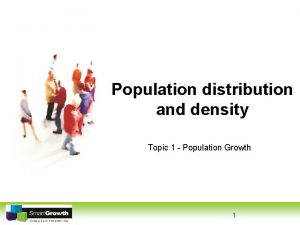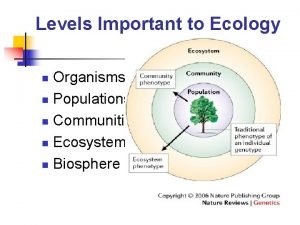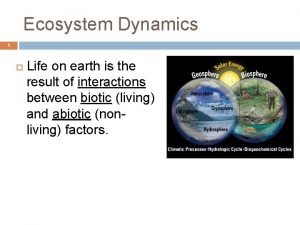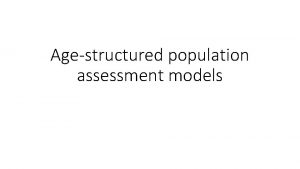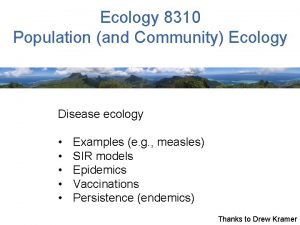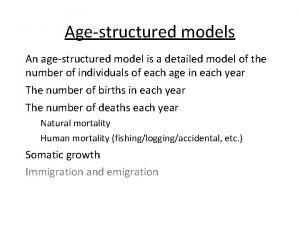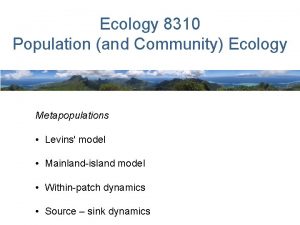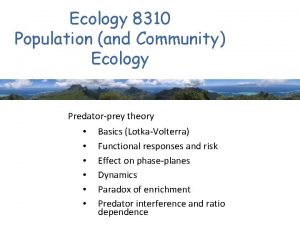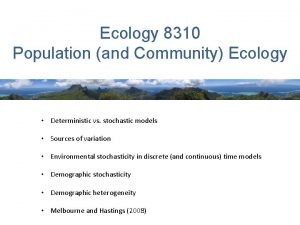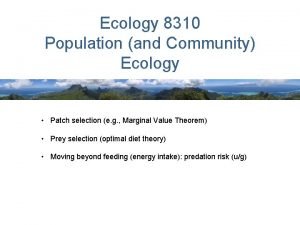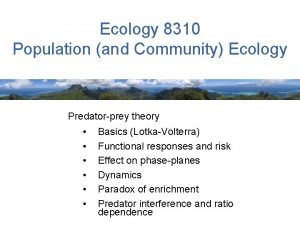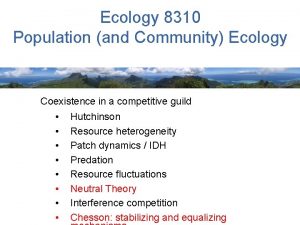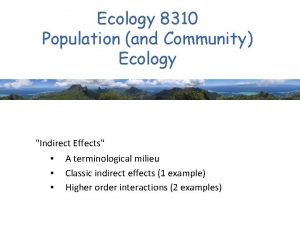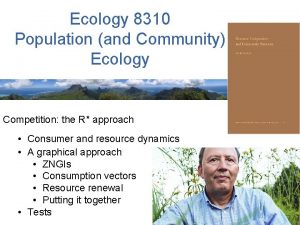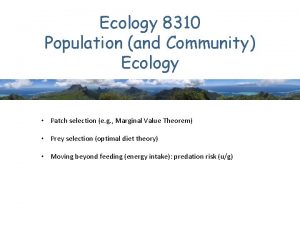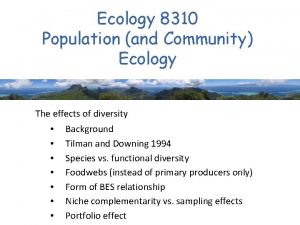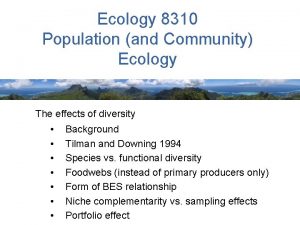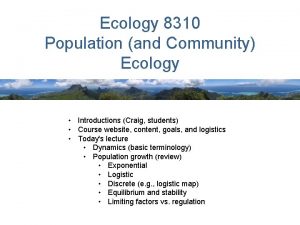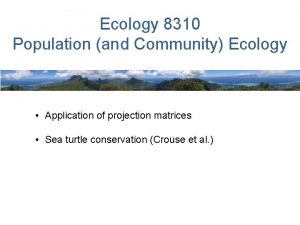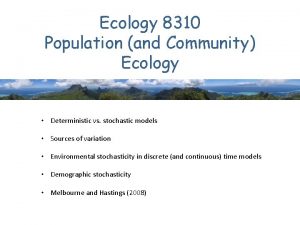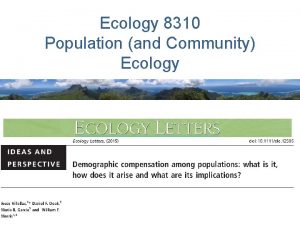Ecology 8310 Population and Community Ecology Agestructured populations













































- Slides: 45

Ecology 8310 Population (and Community) Ecology • Age-structured populations • Stage-structure populations • Life cycle diagrams • Projection matrices

Context: Sea Turtle Conservation (But first … background)

Population Structure: From vianica. com

Life Cycle Diagram: Age 0 Age 1 Age 2 Age-based approach. What now? Age 3

Life Cycle Diagram: Project from time t to time t+1…. P 13 Group 1, Age 0 1 -P 21 Dead P 21 Group 2, Age 1 1 -P 32 1 -P 43 P 14 Group 3, Age 2 1 -P 54 P 43 Group 4, Age 3

Projections: • nx, t = abundance (or density) of class x at time t. • So, given that we know n 1, t, n 2, t, …. • And all of the transitions (Pij's)… • … What is n 1, t+1, n 2, t+1, n 3, t+1, … ?

Projections: n 2, t+1 = ? ? = P 21 x n 1, t P 14 P 13 Group 1, Age 0 Dead P 21 Group 2, Age 1 P 32 Group 3, Age 2 P 43 Group 4, Age 3

Projections: n 1, t+1 = ? ? = (P 14 x n 4, t) + (P 13 x n 3, t) P 14 P 13 Group 1, Age 0 Dead P 21 Group 2, Age 1 P 32 Group 3, Age 2 P 43 Group 4, Age 3 Project what?

Is there a way to write this out more formally (e. g. , as in geometric growth model)?

Matrix algebra: n is a vector of abundances for the groups; A is a matrix of transitions Note similarity to:

Matrix algebra: For our age-based approach

Matrix algebra:

Our age-based example: P 14 P 13 Group 1, Age 0 P 21 Group 2, Age 1 P 32 Group 3, Age 2 P 43 Group 4, Age 3

A simpler example: P 12 Group 1 P 21 Group 2 P 13 P 32 Group 3

Simple example: What is nt+1?

Simple example:

Simple example: P 12 Group 1 P 21 Group 2 P 13 P 32 Group 3

Simple example: Time: 1 2 3 4 5 6 7 n 1, t 100 0 60 90 36 108 103 n 2, t 0 60 0 36 54 22 65 n 3, t 0 0 30 0 18 27 11 Nt 100 60 90 126 108 157 179

Time: 1 2 3 4 5 6 n 1 100 0 60 90 36 108 n 2 0 60 0 36 54 22 n 3 0 0 30 0 18 27 N 100 60 90 126 108 157 n 1/N n 2/N n 3/N 1. 0 0 0. 60 0 1. 50 0. 67 0 0. 33 1. 40 0. 71 0. 29 0 0. 86 0. 33 0. 50 0. 17 1. 45 0. 69 0. 14 0. 17 1. 14 Annual growth rate=(Nt+1/Nt)

Let's plot this…

Dynamics: What about a longer timescale?

Dynamics: Are the age classes growing at similar rates?

Dynamics: Thus, the composition is constant…

Age structure: Constant proportions through time = Stable Age Distribution (SAD) If no growth (Nt=Nt+1), then: 1. Stationary Age Distribution 2. Stat. AD is the same as the “survivorship curve”

The right eigenvector of A gives the Stable Age Distribution.

Dynamics: If A constant, then SAD, and Geometric growth Nt+1/Nt = λ Nt=N 0λ t Here, λ =1. 17

λ is the dominant eigenvalue of A (positive and larger than all other eigenvalues); it is the asymptotic growth rate that arises from A

How do we obtain a survivorship schedule from our transition matrix, A?

Survivorship schedule: p(x) = Probability of surviving from age x to age x+1 (same as the “survival” elements in age-based transition matrix: e. g. p(0)=P 21). l(x) = Probability of surviving from age 0 to age x l(x) = Πp(x) ; e. g. , l(2)=p(0)p(1)

Survivorship schedule: Recall: “Group” 1 2 3 4 Age, x 0 1 2 3 Px+2, x+1=p(x) 0. 6 0. 5 0. 0 l(x) 1. 0 0. 6 0. 3 0. 0

Survivorship curves: Age specific survival?

Back to the question: The age distribution should mirror the survivorship schedule. Does it?

Survivorship curves: Does the age distribution match the survivorship curve? “Group” Age, x l(x) 1 2 3 0 1 2 1. 0 0. 6 0. 3 Stable A. D. 0. 58 0. 30 0. 13 Rescaled AD 1. 0 0. 52 0. 22 Why not?

Survivorship The population increases 17% each year curves: So what was the original size of each cohort? And how does that affect SAD?

Survivorship curves: Population Growth! How can we adjust for growth? l(x) 1. 0 0. 6 0. 3 Stable A. D. Adjusted by Rescaled growth 0. 58 =0. 58/1. 172 1. 0 0. 30 =0. 30/1. 17 0. 6 0. 13 0. 3

Survivorship curves: 1. Static Method: count individuals at time t in each age class and then estimate l(x) as n(x, t)/n(0, t) Caveat: assumes each cohort started with same n(0)! 2. Cohort Method: follow a cohort through time and then estimate l(x) as n(x, t+x)/n(0)

Reproductive Value: • Contribution of an individual to future population growth • Depends on: • Future reproduction • Pr(surviving) to realize it • Timing (e. g. , how soon – so your kids can start reproducing)

Reproductive Value: • left eigenvector of A • How can we calculate it without doing linear algebra? • Put 1 individual in a stage • Project • Compare future N to what you get when you put the 1 individual in a different stage

Reproductive Value: From vianica. com • Scaled to 1 for newborn • Increase from birth to maturation (why? ) • May continue to increase after maturation • Eventually it declines (why? )

But how did we get λ , RV, and SAD?

Methods: 1) Crank it out (look at long-term results) 1) Eigenvectors and eigenvalues 1) Dominant eigenvalue gives λ 2) Left eigenvector gives v(x), Repro. Value 3) Right eigenvector gives w(x), SAD See Caswell 2001

Issues we've ignored: • • Non-age based approaches Density dependence Other forms of non-constant A How you obtain fecundity and survival data (and use it to get A) • Issues related to timing of the projection vs. birth pulses • Sensitivities and elasticities • Linear algebra (how to obtain eigenvectors)

Generalizing the approach: Age-structured: Age 0 Age 1 Age 2 Age 3 Stage 4 Stage-structured: Stage 1 Stage 2 How will these models differ?

Age-structured: Age 0 Age 1 Age 2 Age 3 Stage 4 Stage-structured: Stage 1 Stage 2

To do: Go back through the previous results for age-structure and think about how they will change for stage-structured populations. Read Vonesh and de la Cruz (carefully and deeply) for discussion next time. We'll also go into more detail about the analysis of these types of models.
 Trng 8310
Trng 8310 Faa form 8310-3
Faa form 8310-3 Chapter 4 section 1 population dynamics
Chapter 4 section 1 population dynamics Section 1 population dynamics
Section 1 population dynamics Population ecology section 1 population dynamics
Population ecology section 1 population dynamics Study guide section 1 population dynamics
Study guide section 1 population dynamics Fig 52
Fig 52 Ecosystem vs community
Ecosystem vs community Clumped dispersion
Clumped dispersion Exponential growth formula ecology
Exponential growth formula ecology Concept 3 population ecology
Concept 3 population ecology Chapter 53 population ecology
Chapter 53 population ecology Chapter 36 population ecology
Chapter 36 population ecology Ecology
Ecology Population ecology def
Population ecology def Chapter 53 population ecology
Chapter 53 population ecology Population characteristic
Population characteristic Chapter 4 section 2 human population answer key
Chapter 4 section 2 human population answer key Population characteristics ecology
Population characteristics ecology Ideal population growth curve
Ideal population growth curve Population definition ecology
Population definition ecology Population ecology
Population ecology Parasitism pictures
Parasitism pictures Chapter 53 population ecology
Chapter 53 population ecology Evolution and community ecology guided notes
Evolution and community ecology guided notes Chapter 5 evolution and community ecology
Chapter 5 evolution and community ecology Chapter 5 evolution and community ecology answer key
Chapter 5 evolution and community ecology answer key Difference between population and community
Difference between population and community Community ecology
Community ecology Chapter 3, section 1: community ecology answer key
Chapter 3, section 1: community ecology answer key Chapter 54: community ecology answer key
Chapter 54: community ecology answer key Definition of community ecology
Definition of community ecology Biological disturbance
Biological disturbance Community definition ecology
Community definition ecology Community ecology
Community ecology Ecology part 1
Ecology part 1 Chapter 54 community ecology
Chapter 54 community ecology Ecology
Ecology Population community ecosystem biosphere
Population community ecosystem biosphere Levels of ecological organization from smallest to largest
Levels of ecological organization from smallest to largest Organism population community ecosystem biosphere
Organism population community ecosystem biosphere Individual population community ecosystem
Individual population community ecosystem Evolution of populations section 16-1 genes and variation
Evolution of populations section 16-1 genes and variation Evolution of populations section 16-1 genes and variation
Evolution of populations section 16-1 genes and variation Ringe til peru
Ringe til peru Chapter 21 vulnerability and vulnerable populations
Chapter 21 vulnerability and vulnerable populations





















